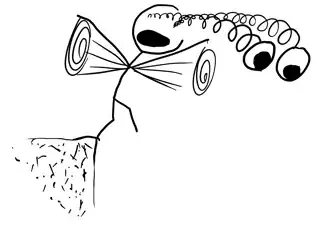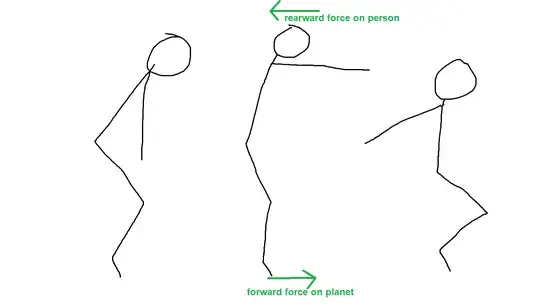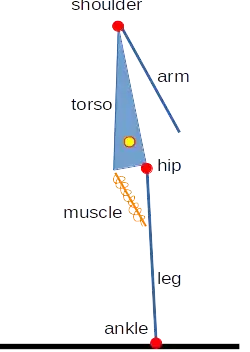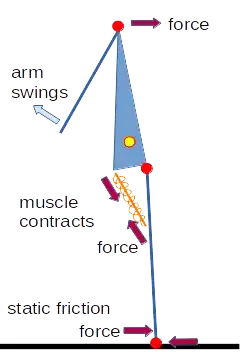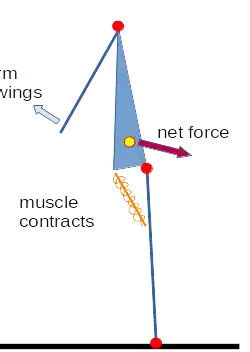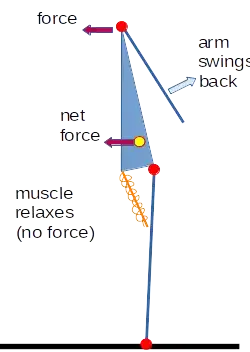Mostly it's the first half swing which helps
There's a reaction mass thing happening with moving the mass of your arms compared to the mass of your body. The force required to move your arms forward applies an equal and opposite force backward on your torso. This will tend to pull your torso back over your feet.
Whilst your body is leaning forwards, your friction with the ground is reduced, and your natural leg movements will tend to push you forwards. If swinging your arms is enough to bring your torso back upright, then friction is improved and your natural leg movements will push you backwards.
Of course if it's not enough then over you go! But there is enough success rate for it to be a good strategy. Learning to use your arms as reaction mass for balance is one of the basic things we develop as babies when we first start walking, so it's a very well-developed reflex. It's not innate (as everyone who's seen a baby learning to walk can testify), it's just something we've used continuously from before we could talk, so the skill becomes reflexive.
Note that this relies on there being a solid surface underneath you, otherwise your equal and opposite reactions will equally well push your legs the wrong way. These reflexes are something you have to consciously unlearn when you start any sport which relies on you standing on a wobbly surface, such as windsurfing or paddle-boarding. For these, you need to develop a different balance reflex where you move your hips to move your centre-mass, pivoting around your ankles. This is actually a better balance technique for when you're stood still, because you're directly moving your body mass, but it doesn't translate well to walking motions.
After that, there will be a measurable effect, but not much
The OP claims that because the arm rotates about its axis as well as about the shoulder joint, it cannot produce a net forward force. This is clearly incorrect though. The net force for continuous arm spinning is of course produced by displacing air, so all we need is more air to be displaced on the back-to-forward part of the spin.
If you try the arm movements for swimming backstroke, you will clearly see that your arm and hand rotate to present your palm, giving maximum cross-sectional area through the air on the half-stroke from behind and passing your waist. As your arm comes back on the other side, you twist your wrist quickly so that your little finger is upwards. Your hand's cross-sectional area through the air is now reduced to only the blade of the hand, and it remains so for the rest of the rotation.
In a more dense medium, this would clearly have significant effects. You absolutely can do backstroke underwater to demonstrate the principle (although of course there are easier ways to swim underwater). In air though, you would need to be spinning those arms really fast, because you need to displace enough air to hold yourself up.
How much? Let's do the sums...
The worst-case of course is countering your entire body mass, in which case you're basically a human helicopter, and then you don't need to worry about falling because you can fly. Let's assume the effect isn't quite that awesome, so you can only support a quarter of your body mass with whirling arms. For an average 80kg adult, that means we need about a 200N force.
Looking at my hand, I can probably cup a half-litre of air, which (at an average air density of 1.2kg/m3) weighs 0.6g. Say 0.5g in round numbers, and for simplicity let's say (because you have two arms) that you're moving 0.5g of air continuously forwards. Let's also simplify the movement and say that you're accelerating this air linearly over a 1m linear distance, and that your arm movement has a 4m circumference (which gives you the speed of your arm, and hence the air). Then for revs/s R and F=ma,
200 = (0.0005 * R) * (((4*R)^2)/2)
8R^2 + 0.0005R - 200 = 0
Solving (and ignoring the negative solution),
R = 80 revs/s
So for your cartoon character capable of whirling their arms like helicopter blades, this could genuinely be a practical strategy. For humans, not so much.
